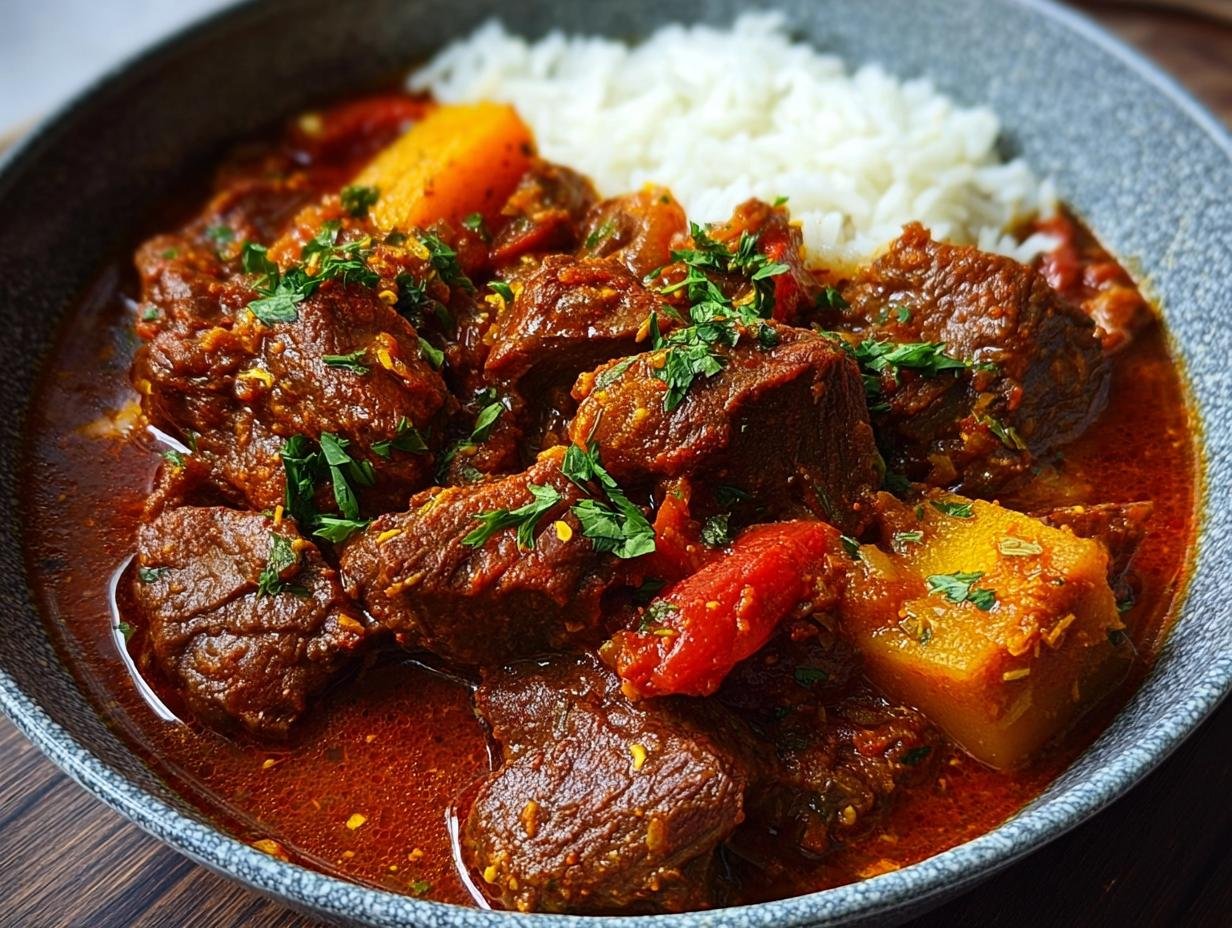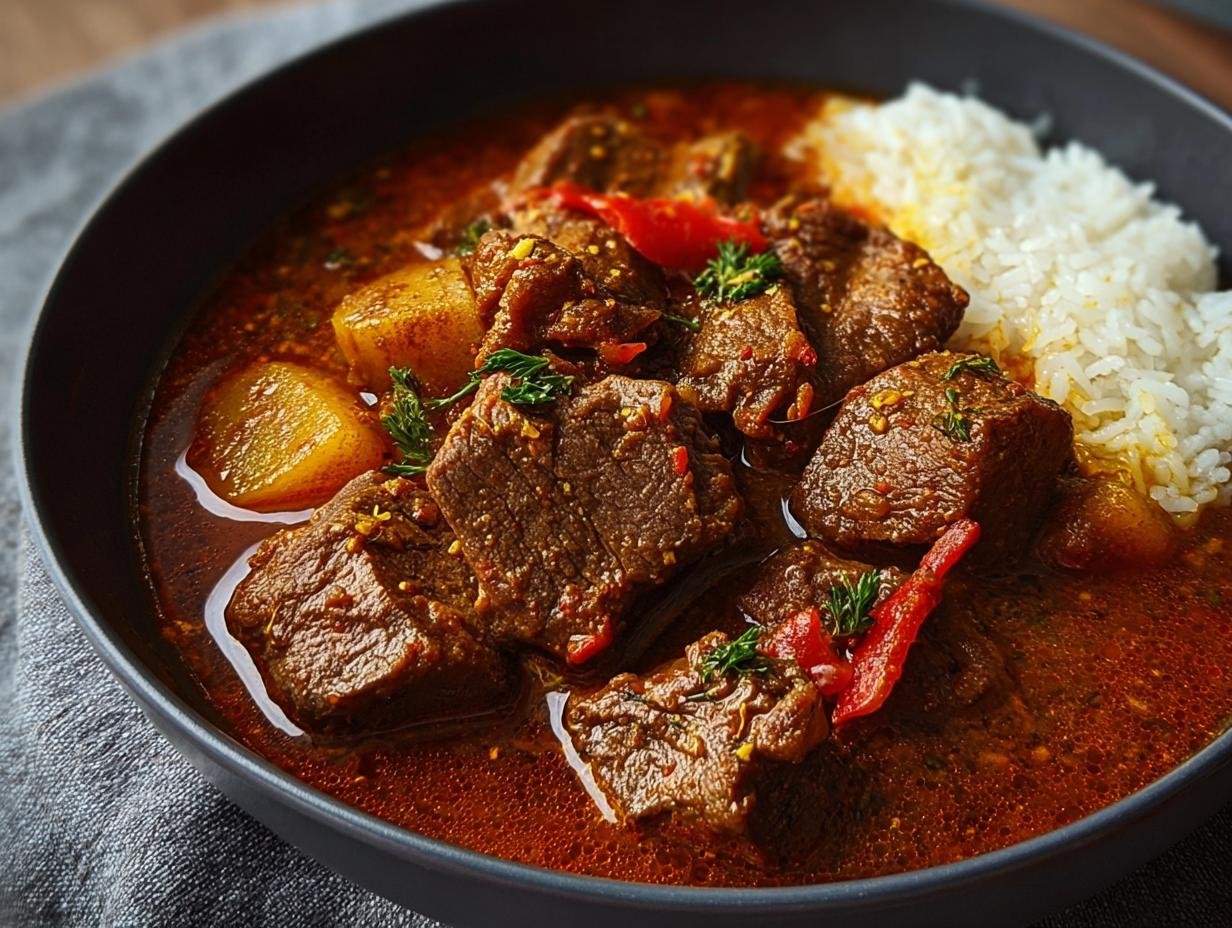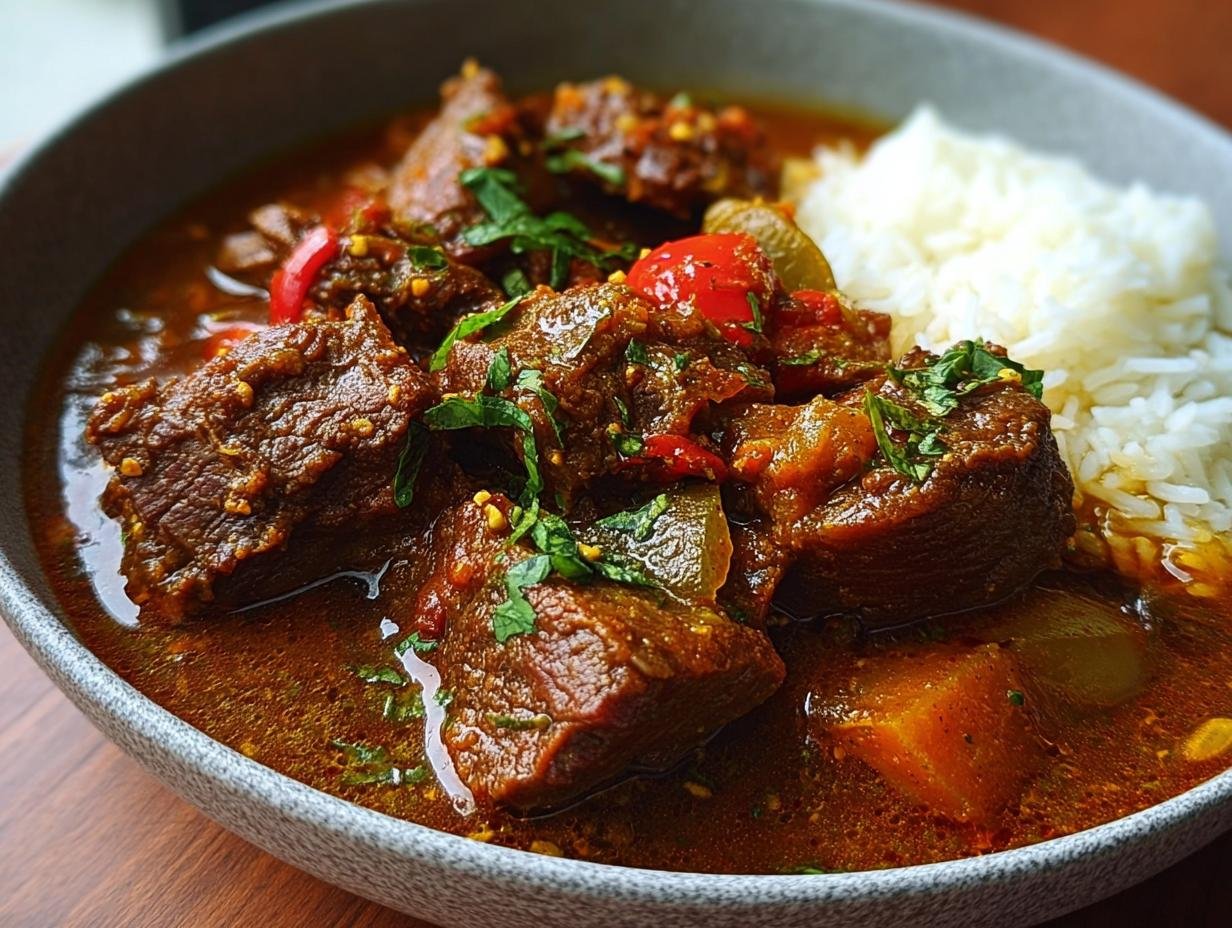Rich Nigerian Beef Stew has a way of making any meal feel like a celebration. I remember the first time I tried an authentic Nigerian beef stew at a friend’s house; the aroma alone was intoxicating, a deep, savory perfume that promised something truly special. The beef was melt-in-your-mouth tender, swimming in a vibrant, slightly spicy tomato sauce that just clung to every grain of fluffy white rice. It’s a dish that instantly transports you, a warm hug in a bowl. If you’re looking to recreate that incredible flavor at home, you’ve come to the right place. Let’s get cooking!
Why You’ll Love This Rich Nigerian Beef Stew
This dish is more than just a meal; it’s an experience! Get ready to fall in love with its incredible qualities:
- Unforgettable Flavor: Prepare your taste buds for a truly flavorful Nigerian beef stew. The slow simmering process allows the spices and aromatics to meld into a complex, deeply savory profile that’s simply irresistible.
- Remarkably Easy to Make: Don’t be intimidated! This is an easy Nigerian beef stew that comes together with straightforward steps, perfect for both beginners and seasoned cooks.
- Ultimate Comfort Food: There’s nothing quite like a warm, hearty bowl of this stew to soothe your soul and bring a sense of home, no matter where you are.
- Incredibly Versatile: Serve it over fluffy white rice, with chewy plantains, or alongside pounded yam – it’s a dish that adapts beautifully to your preferences.
- Rich Cultural Heritage: Enjoy a taste of West African tradition with this classic dish, a staple that brings families together.
- Tender, Juicy Beef: We’ll guide you to perfectly cooked beef that melts in your mouth, soaking up all the delicious sauce.
Ingredients for Authentic Nigerian Beef Stew
Gathering these ingredients is the first step to creating a truly delicious and rich Nigerian beef stew recipe. You’ll need:
- 2 lbs beef (bone-in or boneless chunks) – I prefer bone-in for that extra richness, but boneless works beautifully too.
- 2 seasoning cubes (Maggi or Knorr) – these are packed with savory flavor!
- Salt to taste – crucial for balancing all those delicious spices.
- 1 teaspoon garlic powder
- 1 teaspoon ginger powder
- ½ teaspoon black pepper
- 4 medium Roma tomatoes – for that vibrant, tangy base.
- 2 red bell peppers – these add sweetness and color.
- 1–2 Scotch bonnet peppers (adjust to taste) – these are key for that signature Nigerian heat, so start with one if you’re unsure!
- 1 large red onion – blended for the sauce.
- 3 cloves garlic
- 1-inch piece of fresh ginger
- ½ cup vegetable oil or palm oil – palm oil gives a more traditional flavor, but vegetable oil is a great alternative.
- 1 small onion (sliced) – for sautéing to build aromatic layers.
- 2 tablespoons tomato paste – it deepens the color and adds a concentrated tomato flavor, essential for a good stew base.
- 1 teaspoon thyme
- 1 teaspoon curry powder
- 1 bay leaf (optional) – adds a subtle herbal note.

How to Make Rich Nigerian Beef Stew
Follow these steps to create an incredibly flavorful and authentic Nigerian beef stew. This process ensures tender beef and a perfectly balanced, rich sauce.
- Step 1: Rinse and cut your beef into bite-sized chunks. Season generously with salt, 2 seasoning cubes, 1 teaspoon garlic powder, 1 teaspoon ginger powder, and ½ teaspoon black pepper. Mix everything thoroughly and let it marinate for at least 30 minutes. Add about ½ cup of water to the pot and boil the beef on medium heat until it’s tender and you have a rich stock. Carefully set both the tender beef and its flavorful stock aside.
- Step 2: While the beef is cooking, prepare your pepper base. In a blender, combine the 4 Roma tomatoes, 2 red bell peppers, 1–2 Scotch bonnet peppers (depending on your heat preference), 1 large red onion, 3 cloves garlic, and the 1-inch piece of fresh ginger. Blend until you achieve a smooth consistency. For an even richer flavor and less acidity, you can optionally pour this mixture into a saucepan and simmer for 10–15 minutes to reduce some of the moisture.
- Step 3: In a large, heavy-bottomed pot, heat ½ cup vegetable oil or palm oil over medium heat. Working in batches, fry the pre-cooked beef chunks until they are nicely browned on all sides. This step adds depth of flavor and texture. Remove the browned beef and set it aside.
- Step 4: In the same pot with the oil (add a little more if needed), sauté the 1 small sliced onion until it becomes fragrant and slightly softened. Stir in 2 tablespoons tomato paste and fry it for about 3–5 minutes, stirring constantly. This helps to cook out the raw tomato flavor and deepen the color.
- Step 5: Now, pour in your blended pepper mix. Fry this mixture on medium-low heat for 15–20 minutes, stirring frequently. You’ll know it’s ready when the oil starts to separate from the sauce and the distinct raw tomato smell has completely disappeared. This frying process is crucial for a good spicy Nigerian beef stew.
- Step 6: Return the browned beef to the pot. Add some or all of the reserved beef stock from Step 1. Stir in 1 teaspoon thyme, 1 teaspoon curry powder, and 1 bay leaf if you’re using it. Taste and adjust seasoning with more salt and seasoning cubes if needed.
- Step 7: Stir everything together well. Cover the pot and let the stew simmer on low heat for another 20–30 minutes. This allows the flavors to meld beautifully, and the beef to fully absorb the delicious sauce, completing how to make Nigerian beef stew.
- Step 8: Stir occasionally during this final simmer. Taste and adjust seasoning one last time. If there’s excess oil on top, you can gently skim it off. For a final touch, garnish with fresh chopped parsley or green onions if desired.

Pro Tips for the Best Nigerian Beef Stew
Achieving that perfect, melt-in-your-mouth texture and deep, complex flavor is easier than you think! Here are my go-to tips for making a truly exceptional Nigerian beef stew.
- Use Bone-In Beef: For the richest flavor and most tender results, I always opt for bone-in cuts like beef shank or brisket. The marrow from the bones adds an incredible depth that you just can’t get from boneless cuts.
- Don’t Rush the Fry: Frying the blended pepper mix until the oil separates is a non-negotiable step. This cooks out the raw tomato taste and intensifies the flavors, creating that signature richness. Be patient!
- Taste and Adjust: Seasoning is key! Always taste your stew throughout the cooking process and adjust salt and seasoning cubes as needed, especially after adding the beef stock.
- Low and Slow Simmer: After combining everything, let the stew simmer on low heat. This allows all those beautiful flavors to meld together perfectly.
What’s the secret to perfect Nigerian beef stew?
The magic lies in the dual cooking process for the beef and the pepper base. Boiling the beef first creates a rich stock, and then frying the blended peppers until the oil separates develops a deep, complex flavor profile, essential for any great Nigerian stewed beef recipe.
Can I make Nigerian beef stew ahead of time?
Absolutely! This stew is fantastic made a day in advance. The flavors actually deepen and meld even further overnight, making it even more delicious. Just reheat gently on the stove.
How do I avoid common mistakes with Nigerian beef stew?
A common pitfall is not frying the pepper mix long enough, leaving a raw tomato taste. Also, under-seasoning is easy to do; make sure to taste and adjust salt and seasoning cubes throughout. Finally, don’t skimp on cooking the beef until it’s truly tender!
Best Ways to Serve Rich Nigerian Beef Stew
This versatile Nigerian beef stew is a star on its own, but it truly shines when paired with the right accompaniments. My absolute favorite way to enjoy it is over a generous bed of fluffy white rice. The way the rice soaks up that delicious, rich sauce is pure bliss – it’s the ultimate comfort food pairing for Nigerian beef stew for rice.
Beyond rice, this stew is also incredible served alongside fried or boiled plantains, offering a lovely sweet contrast to the savory, spicy stew. For a more traditional experience, try it with pounded yam or boiled yam. A simple side salad or some steamed vegetables can also provide a refreshing balance to the richness of the stew.
Nutrition Facts for Rich Nigerian Beef Stew
Here’s a look at the estimated nutritional breakdown for a serving of this delicious Nigerian beef stew. These figures help you understand the components of this hearty dish.
- Calories: 380 kcal
- Fat: 26g
- Saturated Fat: 6g
- Unsaturated Fat: 17g
- Trans Fat: 0g
- Protein: 30g
- Carbohydrates: 9g
- Fiber: 2g
- Sugar: 4g
- Sodium: 800mg
- Cholesterol: 90mg
Nutritional values are estimates and may vary based on specific ingredients and portion sizes used.
How to Store and Reheat Rich Nigerian Beef Stew
This Nigerian beef stew tastes even better the next day, so don’t hesitate to make a big batch! Once it has cooled down completely, transfer the stew into airtight containers. You can store it in the refrigerator for 3-4 days. If you plan on keeping it longer, freezing is an excellent option. Properly stored, your Nigerian beef stew can last in the freezer for up to 3 months. This makes it a perfect candidate for meal prepping and having a delicious, home-cooked meal ready whenever you need it.
When you’re ready to enjoy your stored stew, the reheating methods are simple. For refrigerated stew, gently reheat it on the stovetop over low to medium heat, stirring occasionally, until it’s heated through. If reheating from frozen, it’s best to thaw it overnight in the refrigerator first. You can then reheat it on the stovetop or even in the microwave in short intervals, stirring between each, until piping hot.
Variations of Nigerian Beef Stew
While the classic Nigerian beef stew is incredible on its own, I love how versatile it is! You can easily adapt this recipe to suit your preferences. Here are a few of my favorite ways to switch things up:
- Nigerian Beef and Vegetable Stew: For a heartier, more complete meal, I often add extra vegetables. Carrots, potatoes, green beans, or even spinach can be stirred in during the last 20-30 minutes of simmering. They soak up the delicious sauce beautifully and add extra nutrients and texture.
- Milder Version: If you’re not a fan of intense heat, no worries! Simply reduce the number of Scotch bonnet peppers or omit them entirely. You can still achieve fantastic flavor with just the bell peppers and onions.
- Different Meat Cuts: While beef is traditional, you can also make a rich Nigerian stew with goat meat or chicken. Just adjust the cooking time as needed to ensure the meat is tender.
- Quick Weeknight Stew: If you’re short on time, using pre-cut stewing beef and simmering it until tender can speed up the process. You can also skip the initial boiling step and cook the beef directly in the sauce, though it might not be quite as rich.
Frequently Asked Questions About Rich Nigerian Beef Stew
Can I use a different type of meat for Nigerian beef stew?
Absolutely! While beef is traditional, this recipe is wonderfully adaptable. You can easily substitute goat meat, lamb, or chicken pieces. Just remember to adjust the cooking time; chicken will cook much faster, while tougher cuts of goat meat might require a longer simmering period to achieve that signature tenderness found in an authentic Nigerian beef stew.
What can I do if my Nigerian beef stew is too oily?
It’s common for stews, especially those using palm oil or fattier cuts of meat, to have a bit of excess oil on top. The best trick is to let the stew cool completely. As it cools, the oil will solidify and rise to the top, making it easy to skim off with a spoon before reheating. You can also achieve this by tilting the pot and scooping the oil from the surface.
How do I make my Nigerian beef stew richer?
To achieve an even richer flavor, consider using bone-in beef cuts like shank or oxtail, as the marrow adds incredible depth. Another tip for a more intense flavor in your rich Nigerian beef stew recipe is to thoroughly fry the tomato paste and the blended pepper mix until the oil separates – this caramelizes the ingredients and concentrates their taste. Don’t rush this step!
Can I make Nigerian beef stew vegetarian?
Yes, you can create a delicious vegetarian version! Replace the beef with firm tofu, large chunks of plant-based meat substitutes, or hearty vegetables like sweet potatoes, firm eggplant, and mushrooms. You’ll want to use vegetable stock instead of beef stock and ensure your seasoning cubes are vegetarian-friendly. The cooking process remains similar, focusing on building those rich, savory flavors.
Print
Rich Nigerian Beef Stew: 1 Flavorful Recipe
- Total Time: 80 minutes
- Yield: 6 servings 1x
- Diet: Vegetarian
Description
Rich Nigerian Beef Stew is a flavorful and comforting West African classic. Tender beef is simmered in a vibrant, spicy tomato and pepper sauce, perfect served over rice or with plantains.
Ingredients
- 2 lbs beef (bone-in or boneless chunks)
- 2 seasoning cubes (Maggi or Knorr)
- Salt to taste
- 1 teaspoon garlic powder
- 1 teaspoon ginger powder
- ½ teaspoon black pepper
- 4 medium Roma tomatoes
- 2 red bell peppers
- 1–2 Scotch bonnet peppers (adjust to taste)
- 1 large red onion
- 3 cloves garlic
- 1-inch piece of fresh ginger
- ½ cup vegetable oil or palm oil
- 1 small onion (sliced)
- 2 tablespoons tomato paste
- 1 teaspoon thyme
- 1 teaspoon curry powder
- 1 bay leaf (optional)
Instructions
- Rinse and cut beef into chunks. Season with salt, seasoning cubes, garlic powder, ginger powder, and black pepper. Mix thoroughly and let it marinate for at least 30 minutes. Add a little water and boil on medium heat until the beef is tender and the stock is rich. Set beef and stock aside.
- In a blender, combine the tomatoes, red bell peppers, Scotch bonnet(s), large red onion, garlic, and ginger. Blend until smooth and set aside. Optional: pour the mixture into a saucepan and simmer for 10–15 minutes to reduce moisture and acidity.
- In a large heavy-bottomed pot, heat vegetable oil over medium heat. Fry the cooked beef in batches until browned on all sides. Remove and set aside.
- In the same oil (add more if needed), sauté sliced onions until fragrant. Stir in tomato paste and fry for 3–5 minutes.
- Pour in the blended pepper mix and fry on medium-low heat for 15–20 minutes, stirring frequently until the oil begins to separate from the sauce and the raw tomato smell disappears.
- Return the browned beef to the pot, along with some or all of the reserved beef stock. Add thyme, curry powder, bay leaf (if using), and adjust seasoning with more salt and seasoning cubes if needed.
- Stir well, cover, and let simmer on low heat for 20–30 minutes to allow flavors to marry and the beef to soak up the sauce.
- Stir occasionally, taste, and adjust seasoning. Skim off excess oil if necessary. Garnish with fresh chopped parsley or green onions if desired.
Notes
- This Nigerian beef stew tastes even better the next day.
- Using bone-in beef cuts like shank or brisket will add richness to the stew.
- Adjust stew consistency by adding stock or water if too thick, or simmer uncovered if too thin.
- Prep Time: 20 minutes
- Cook Time: 60 minutes
- Category: Main Dish
- Method: Stewing
- Cuisine: Nigerian
Nutrition
- Serving Size: 1 cup
- Calories: 380 kcal
- Sugar: 4g
- Sodium: 800mg
- Fat: 26g
- Saturated Fat: 6g
- Unsaturated Fat: 17g
- Trans Fat: 0g
- Carbohydrates: 9g
- Fiber: 2g
- Protein: 30g
- Cholesterol: 90mg

